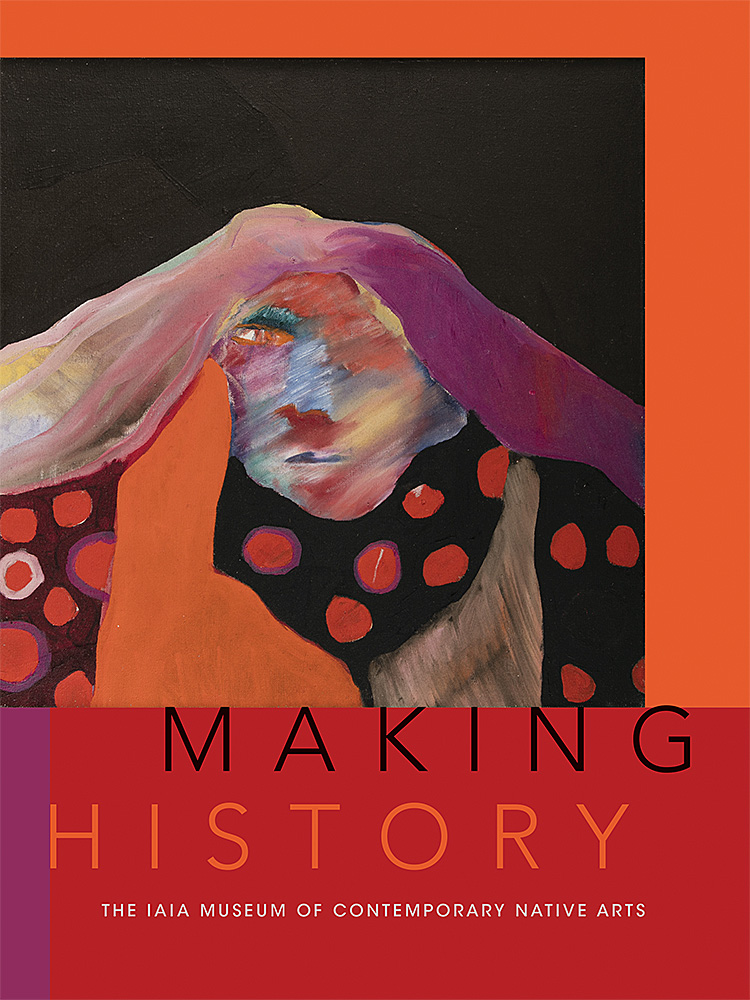
Making History: IAIA Museum of Contemporary Native Arts,
University of New Mexico Press (2020) The Museum of Contemporary Native Arts (MoCNA) Institute of American Indian Arts (IAIA), Santa Fe, New MexicoCover Art: Bill Soza War Soldier, Self Portrait, Painting, Oil on Canvas, 1968, IAIA Museum of Contemporary Native Arts (MS - 22).
University of New Mexico Press
Download UNM Press PDF
Senior Editor Nancy Marie Mithlo, Ph.D.
Contributing authors: Robert Martin, Ph.D. President, Institute of American Indian Arts; Tatiana Lomahaftewa Singer, B.A. Curator of Collections IAIA Museum of Contemporary Native Arts; Ryan Flahive, M.A. IAIA Archivist; Chapter contributors: David Wade Chambers, Ph.D. IAIA Emeritus Native Eyes Director; Charles Dailey, B.A. IAIA Emeritus Museum Studies faculty; Lara Evans, Ph.D. Professor Art History, Institute of American Indian Arts; Stephen Fadden, M.A. Programming Director, Poeh Cultural Center; Nancy Marie Mithlo, Ph.D. Professor of Gender Studies, UCLA; Suzanne Newman Fricke, Ph.D. Adjunct Professor of Art History, IAIA; Patsy Phillips, M.A. Director, Museum of Contemporary Native Arts, IAIA; John Paul Rangel, Ph.D. Creative Director, Asphalt Apache Design; Jessie Ryker-Crawford, Ph.D. IAIA Professor of Museum Studies, IAIA; Dave Warren, Ph.D. IAIA Emeritus Cultural Research and Resource Development Center Director; Poems: Alex Jacobs, B.F.A.; Elizabeth Woody, M.P.A.
Reviews
McEnaney, Lillia. Review of Making History: The IAIA Museum of Contemporary Native Arts, edited by Nancy Marie Mithlo. Southwest Contemporary. January 27, 2021. southwestcontemporary.com/book-review-making-history-iaia/
Quimby, Sara. Review of Making History: The IAIA Museum of Contemporary Native Arts, edited by Nancy Marie Mithlo. Art Libraries Society of North America, September 2021. dx.doi.org/10.17613/5eyc-ab14
Ernest, Marcella. Review of Making History: The IAIA Museum of Contemporary Native Arts, edited by Nancy Marie Mithlo. Western Historical Quarterly, Volume 53, Issue 1, Spring 2022, Pages 84–86. doi.org/10.1093/whq/whab123
Lambrecht, Winifred. Review of Making History: The IAIA Museum of Contemporary Native Arts, edited by Nancy Marie Mithlo. Journal of Folklore Research, April 8, 2022. wayback.archive-it.org/219/20220512011142/https://jfr.sitehost.iu.edu/review.php?id=2586
Titterington, David. Review of Making History: The IAIA Museum of Contemporary Native Arts, edited by Nancy Marie Mithlo. Great Plains Quarterly, Volume 43, Number 1, Winter 2023, pp. 107-108. doi.org/10.1353/gpq.2023.a897854